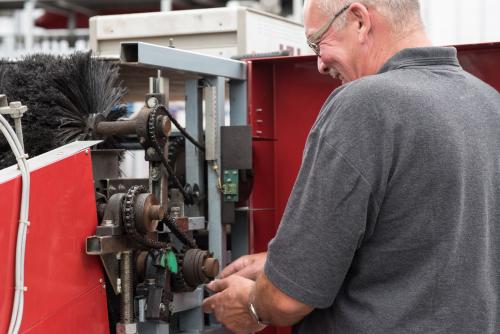10 Tips for Maintaining Used Agricultural and Horticultural Machinery

Machines are essential for any agricultural enterprise, and proper maintenance is crucial to extend their lifespan and ensure optimal performance. As a proud owner of one or more agricultural machines, you want to ensure that your investment remains profitable. Here are 10 valuable tips for maintaining your agricultural machinery.
1. Regular Cleaning:
After use, keep your agricultural machinery free from dirt, mud, and crop residues. The method of cleaning depends on the machine, but be cautious with water. Use a pressure washer to clean it thoroughly. A clean machine ensures that moving parts continue
to function smoothly.
2. Lubricate Moving Parts:
Pay extra attention to lubrication points on agricultural machinery. Well-lubricated parts and chains reduce friction and, consequently, wear. Use the appropriate lubricant and follow the recommended lubrication schedule. Also, check if it's clean
enough and if the rubber parts are not too worn.
3. Check Fluid Levels:
Regularly monitor oil and coolant levels. Ensure that you use the recommended oils and fluids, replacing them according to the manufacturer's schedule. This is especially crucial for tractors or closed systems lubricated by oil.
4. Inspect Electrical Systems:
Check wiring and electrical connections for signs of wear, breaks, or corrosion. Address issues immediately to prevent unnecessary breakdowns.
5. Inspect Tires:
Regularly check tire pressure and wear patterns. Incorrect tire pressure can lead to reduced fuel efficiency and uneven wear, negatively affecting maneuverability. Replace worn tires to prevent unnecessary damage.
6. Check Filters:
Air filters, fuel filters, and hydraulic filters should be inspected and replaced regularly. Clean filters ensure efficient operation and protect the machine from dirt and particles.
7. Calibrate Equipment:
If your agricultural machine is equipped with precision technology, such as GPS systems, ensure regular calibration. Accurate equipment improves performance and saves costs.
8. Check Brakes:
Brakes are essential for safety. Regularly check brake fluid and brake pad thickness. Replace worn brake components immediately to maintain braking performance.
9. Keep Manuals:
Keep the manuals for your agricultural machinery in an accessible place. They contain valuable information about maintenance intervals, specifications, and manufacturer recommendations.
10. Maintenance Planning:
Conduct both minor and major maintenance before or after the season to prevent downtime during busy periods. This includes checking and, if necessary, replacing worn parts and conducting thorough inspections, such as cleaning, lubricating, and fluid
replacement.
By following these tips, you can extend the lifespan of your used agricultural machinery and ensure optimal performance in the field. Invest in regular maintenance to protect your valuable agricultural investments.
Additional Tip:
As you spend time working with your machines, pay attention to any changes in their operation. Be alert to detect issues early, allowing for timely repairs or maintenance. If immediate repair or maintenance is not possible, document the work needed for a later time.
Maintenance of Conveyor Belts:
For conveyor belts, many of the above tips apply, but there are additional considerations. A conveyor belt can deviate on the roller, leading to potential damage and wear. Causes may include contamination between the roller and the conveyor belt, misalignment of the roller, or worn-out components.
To prevent this, ensure that:
- The bottom of the conveyor belt and the roller is free from contamination.
- The roller is properly aligned. If adjusting the roller, let the conveyor belt run for a few minutes to observe its reaction after the adjustment.
- Preferably choose a conveyor belt with a straight running belt. This belt at the bottom of the band keeps the belt in a fixed position on the roller, reducing the likelihood of it deviating, thus extending the life of the conveyor belt.
 Request an offer (
Request an offer (